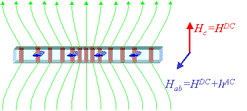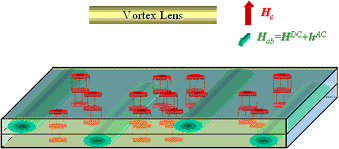Researchers propose breakthrough devices to control the motion of magnetic fields
|
As integrated circuits become smaller and smaller, it becomes increasingly difficult to create the many "guiding channels" that act like wires to move electrons around the circuit components. This difficulty in wiring nano-circuits must be overcome if researchers are to continue developing the microscopic machines and sensors that represent the wave of the future in nanotechnology. A similar problem exists for researchers developing better magnetic imaging tools for medical diagnostics. Here the goal is to control the motion of magnetic field lines within the superconducting material, so that their motion does not produce noise that degrades the performance of the diagnostic device. A new approach and several novel devices described in a recent article in Nature Materials offer hope that the noise challenge has been overcome.
Magnetic fields penetrate superconducting materials via lattices of quantized magnetic flux, called vortices because electrons whirl around them without dissipating energy. Electrical currents, externally applied to superconducting devices, induce the motion of these magnetic flux quanta. This vortex motion produces noise that degrades the device performance in practical applications, such as the sensitive measuring of the magnetic fields produced by the brain. Therefore, the precise control of the motion of these vortices is of central importance for applications involving superconducting materials. By controlling the motion of quanta inside superconducting materials, the new devices allow the design of micro-machines such as "pumps," "diodes" and "lenses" of magnetic flux quanta to create specific magnetic profiles within a given sample or device. This would give designers the ability to remove unwanted flux trapped inside superconducting devices and enable researchers to increase the magnetic field in designated target regions inside materials, which would "magnetically focus" nearby magnetic particles. Inspired by the design of biological "motors" that use sawtooth-shaped spatially-asymmetric structures (one slope of the sawtooth-shaped structure has a steep slope, and the other one a mild slope) to move small objects, Nori and Savel’ev propose using time-asymmetric forces to achieve a similar sawtooth pattern. By repeatedly pushing slowly in one direction, and fast in the opposite direction, they force magnetic flux quanta to move from one point to another inside materials. Their proposed solid-state devices could be used in specific technological applications, including the removal of unwanted fluctuating vortices inside the most sensitive magnetic field sensors used for medical imaging, and to sculpt the magnetic flux profile inside superconducting materials as needed for specific applications. Moreover, these devices achieve control without having to resort to the cumbersome electron-beam lithography or irradiation techniques that are now used to pattern the host material. "[The researchers’] groundbreaking idea is to apply a current or magnetic field to the superconductor that is asymmetric in time, rather than space," said G. D’Anna of the Ecole Polytechnique Fédérale de Lausanne in Switzerland, writing in the same issue of Nature Materials. "This remarkable proposal makes it possible to create asymmetric flux motion, which should inspire experimentalists to build a new generation of superconducting devices for controlling magnetic flux quanta." One of the devices, for example, acts like a convex or concave lens, allowing the creation of a "changeable magnetic landscape" inside the superconducting material (see the two schematic diagrams of "magnetic lenses"). But the authors also stress that their idea has a broader scope. "These are a whole new class of micro-devices," Nori says. "The point is that in a complex system, a time-asymmetric external force applied to one set or species of moveable objects can precisely control the dynamics of another subset, even without the external force directly interacting with the latter. This allows novel ways of indirect manipulation and control of the motion of one species of particles by using another type that interacts with it. For instance, small particles with different electric charges or different magnetic moments could be manipulated via this technique." The manuscript is available from https://doi.org/10.1038/nmat746 or from the authors. E-mail contact: nori@umich.edu Related links: Prof. F. Nori’s web page: www-personal.engin.umich.edu/~nori/
Contact: Judy Steeh |
|
University of Michigan News Service, 412 Maynard, Ann Arbor, MI 48109, newsrel@umich.edu |

